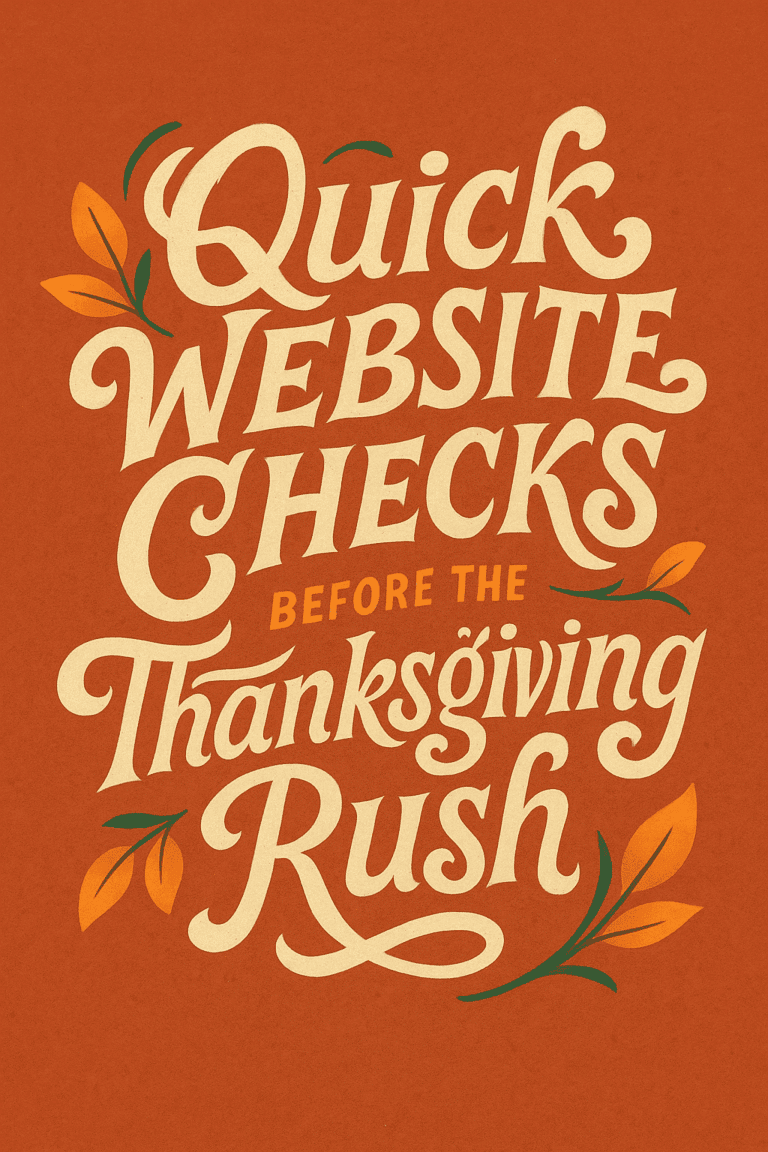
You don’t need to be a web developer or an SEO wizard to understand how your website is performing—or what might be holding it back. Whether you’re a small business owner, a marketing manager, or someone just trying to get better results from your website, doing a basic audit yourself is not only possible—it’s powerful.
In this guide, we’re going to walk through how to audit your website from a non-technical point of view. No code, no jargon, no stress. Just clear steps you can take to see what’s working, what’s broken, and what you can improve.
Let’s dive in.
1) Start With Your Goals
Before you dig into data or design, step back and ask: What is the goal of your website?
For most businesses, it’s something like:
- Get more leads
- Book more appointments
- Sell more products
- Educate and inform
If your website isn’t supporting those goals, no amount of flashy design will fix that.
Action Step:
Write down the top 1–2 goals for your website. Then, as you audit, ask yourself: Is this page helping achieve that?
2) Look at the Homepage First
Your homepage is like your storefront window. It should clearly communicate who you are, what you offer, and why someone should care—all within a few seconds.
Check for:
- Clear messaging: Can someone understand what you do in 5 seconds?
- Call to action: Is it obvious what the visitor should do next?
- Navigation: Is it simple and easy to find key pages?
- Mobile view: Open your homepage on your phone. Does it look clean? Is it easy to scroll and click?
Action Step:
Ask someone unfamiliar with your business to visit your homepage and describe what you do. If they struggle, your messaging may need work.
3) Test the Website Speed (It’s Easy)
A slow website is a visitor killer. People don’t wait—they leave.
Free tools to use:
Just copy your website’s URL into one of those tools and let it run.
What to look for:
- A score above 80 is decent
- Anything red (or under 50) should be looked at
- Focus on things like image sizes and server response times
You don’t need to fix the technical stuff yourself—but knowing what’s slow can help your developer (or us) fix it.
4) Check Your Site on Mobile and Tablet
Most traffic these days is mobile. If your site only looks good on a desktop, you’re losing customers.
What to look for:
- Does the site look clean and uncluttered on your phone?
- Are buttons easy to click with your thumb?
- Do images and text load properly and fit the screen?
Action Step:
Use your phone and a tablet to explore every major page. Make notes of anything that feels off, broken, or hard to use.
5) Go Through Your Pages Like a Customer Would
Pretend you’re a brand new visitor. Ask yourself:
- Is this page answering my questions?
- Is it easy to find what I’m looking for?
- Do I feel confident in this company?
Pages to check:
- About Page: Does it build trust?
- Contact Page: Is there a working form, phone number, and map?
- Services/Product Pages: Are they clear, well-written, and benefit-focused?
- Blog (if you have one): Is it up to date or does it look abandoned?
6) Test Every Link and Button
Dead links, broken buttons, or outdated info destroy credibility.
What to do:
- Click every button and menu item
- Submit every form (try it yourself)
- Try downloading anything offered
- Check social media links
Action Step:
Use a link checker like BrokenLinkCheck.com to find dead links quickly.
7) Look at Your Content With Fresh Eyes
You’re probably too familiar with your own content, which means you might not notice if it’s vague, outdated, or confusing.
Check for:
- Outdated offers or info
- Jargon-heavy language
- Walls of text (break these into shorter paragraphs)
- Missing calls to action
Tip: Read your content out loud. If it sounds awkward or robotic, rewrite it.
8) Do a Basic SEO Check (No Tools Needed)
Search engines need to understand your site—but so do humans.
Look at each page’s:
- Page title (what appears in browser tabs)
- Headings (clear, helpful headlines throughout the page)
- Meta description (what shows up in search results)
You can see these by Googling your business and looking at how your site appears in results.
Action Step:
Does each page:
- Have a clear, relevant title?
- Summarize the page well in its search description?
- Use headings to break up content?
9) Check Image Quality and File Sizes
Images are important—but they shouldn’t slow down your site.
What to look for:
- Blurry or stretched images? Replace them.
- Large file sizes? Compress them with a tool like TinyPNG.
- Are they named properly? Avoid “IMG_1234.jpg”—use names like “longview-web-design.jpg” for better SEO.
10) Is Your Site Secure?
Look at the address bar in your browser. Does your site start with “https://” and show a lock icon? If not, your site isn’t secure.
Visitors—and Google—will penalize sites that aren’t secure.
Action Step:
If you see “Not Secure,” talk to your web host or developer. You may need an SSL certificate (often free).
11) Review Your Analytics (Without Getting Lost)
If you have Google Analytics or another tracking tool installed, you can get insights like:
- How many people visit your site
- What pages they go to
- Where they leave
You don’t need to understand everything—just look at trends.
Things to note:
- Is traffic growing or shrinking?
- Are visitors leaving quickly (bounce rate high)?
- What are the most visited pages?
12) Check for Trust-Builders
Visitors want to feel safe doing business with you.
Look for:
- Testimonials or reviews
- Clear contact info
- Photos of your team or office
- Certifications or memberships (if relevant)
If your site feels generic, people won’t trust it.
Action Step:
Add at least 1–2 trust elements to your homepage and service pages.
13) Is There a Clear Next Step on Every Page?
A good website guides the visitor, not just informs.
Check each page for:
- A button, link, or prompt
- A clear action (“Call now,” “Get a quote,” “Book a session”)
- Consistency in color, wording, and placement
Don’t make people guess what to do.
14) Check Accessibility Basics
You don’t need to be an expert to make your site more accessible.
Easy things to improve:
- Use high contrast between text and background
- Make sure text is large enough to read easily
- Add alt text to images
- Avoid flashing animations or auto-play videos
Bonus: Google likes accessible websites too.
15) Ask for Outside Feedback
Fresh eyes catch things you’ll miss.
Ask:
- A customer
- A friend who’s never seen your site
- Someone in your industry
Give them a task: “Can you find our pricing page?” or “What do you think we offer?”
What to Do With Your Audit Results
Once you’ve gone through this checklist, you’ll likely have a list of things to fix or improve. Don’t try to tackle them all at once.
Here’s how to prioritize:
- Fix anything that’s broken or misleading
- Improve your homepage and key service pages
- Speed up your site and improve mobile usability
- Add calls to action and build trust
- Clean up outdated content
If you’re not comfortable making changes yourself, this is a great time to hand your notes to a web designer or developer who can help. Better yet, let us help.
Ready for a Professional Website Audit?
At Graticle Design, we offer personalized website audits and give you expert, actionable feedback. You’ll get a prioritized list of what to fix, why it matters, and how to do it (or we can handle it for you).
Don’t guess what’s wrong with your site. Know for sure. Reach out today.





